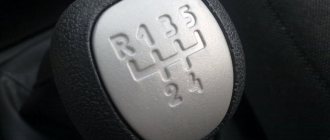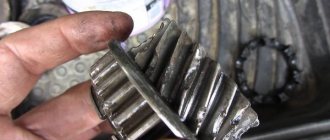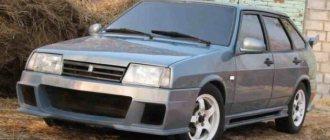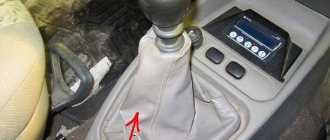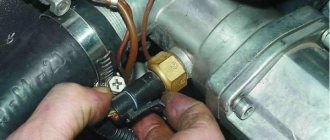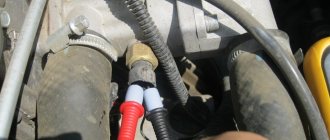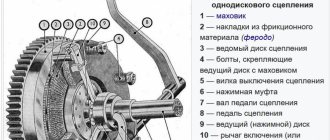A manual transmission is more reliable than other types due to the lack of electronic brains. However, manual transmissions also have their own “diseases,” one of which is gear slippage. It is not difficult to determine the breakdown. The main features are as follows:
- acceleration disappears;
- speed drops;
- the control lever goes into neutral on its own (without your participation).
When you try to engage the transmission again, the failure repeats. To keep the lever in the desired position “at speed”, you will need to constantly hold it with your hand.
We recommend that you immediately contact a car service center, where they will fix the problem for you.
Modern multi-speed gearboxes allow you to get to your destination by eliminating one gear.
What to do if gears do not engage while the engine is running
Sooner or later, any motorist is forced to recognize the appearance of problems in the operation of the gearbox.
Mechanical transmissions break down especially often, and the malfunction can occur spontaneously and unexpectedly, but more often than not, gradually, manifesting itself in various uncharacteristic sounds when shifting gears, as well as difficulties in turning them on. If you cannot move with the engine running, you will have to find out the reason and eliminate it.
Advice for motorists
Above we have already talked about why the reverse gear on the VAZ 2114 does not engage and how to correct this situation. But it should also be noted that proper and timely care of the gearbox will help either completely avoid such a situation or postpone it for as long as possible.
There are only two basic rules for this care:
- Change gears, as well as accelerate and brake the vehicle as smoothly as possible, without jerking.
- Periodically check the oil level, replenish it as it is used, and also replace the entire volume if it is worn out.
These simple rules will help to significantly increase the service life of the entire box and its individual parts.
Common causes of gear shifting problems
There may be many reasons why you cannot move the gearshift lever to the working position. And they are not always associated with a malfunction of the box itself - in some cases the culprit is the clutch, sometimes the engine. In any case, to find out the cause yourself, you must have the appropriate knowledge and experience - otherwise there is a high risk that you will not be able to do this or that as a result of your actions you will have to carry out more complex and expensive repairs.
If the gears do not engage with the engine running due to a malfunction of the gearbox, it will require dismantling and troubleshooting - an operation that requires great care. The same can be said about the clutch. However, it is better to proceed to a more detailed description of possible problems and ways to eliminate them.
New or refurbished old?
If replacing the gearbox cannot be avoided, it is worth considering one very attractive option - installing a rebuilt gearbox. To do this, companies purchase old, damaged boxes, restore them to the highest possible quality and offer installation with a guarantee.
Disassembled gearbox
As practice shows, such gearboxes are approximately 30-70% cheaper than purchasing a new gearbox.
There is only one important condition for successful savings on such significant repairs. It must be a reliable, trusted company
Such companies value their own reputation, so they do not deal with fakes or low-quality repairs. In order to receive positive customer feedback and attract new customers, they simply must do everything well, conscientiously. That’s why today there are fly-by-night companies and companies where, over the years of work, they have established themselves as a reliable and responsible specialist in repairing and replacing gearboxes. You yourself understand perfectly well who you need to contact if you have problems with your box.
Malfunctions when turning on gears and their elimination
The main components of a modern car are characterized by the same operating principles, despite significant differences in their design. In particular, this also applies to manual transmissions (if we do not consider rear-wheel drive cars, in which the lever is connected directly to the transmission).
Front-wheel drive vehicles can have either a longitudinal or transverse gearbox. In the latter case, a link is used for communication between the motor and the gearbox; on some models (for example, on the Ladovsky Vesta and Kalina) a cable drive is used. It is considered simpler and more reliable, but this design is not without its drawbacks and can fail.
So, let's look at the main reasons why gears do not engage when the engine is running.
Traction, drawstring
Since we have already mentioned domestic cars with a transverse power unit (from the “Nine” to the “Priora”), then when the above-mentioned problem appears, it is first necessary to begin the search for the culprits with these mechanisms.
If you notice that when the car starts moving, the gearbox lever rattles chaotically and unpleasantly, most likely it is the rocker that has flown out of its mounting location. This type of malfunction occurs especially often on cars of the Lada Samara family of the first two generations. The solution is to replace the link or fastener element with new ones. We can say that this is the most obvious and easily fixable malfunction of this kind.
Cable
On cars of later years of production, a cable is used instead of a rocker. If this cable breaks, you will not be able to engage the gear, but not only with the engine running, but also with the engine turned off. This is what will indicate that the drive cable is the likely culprit. Replacing it is not difficult, and it is inexpensive compared to other components and parts.
Insufficient transmission oil level
The box, like the engine, may lose its seal, which will lead to lubricant leakage. If there is a deficiency of it, you will feel that the gears are “stuck” with strain, since the engagement of the gears in the absence of oil occurs with great difficulty. If the problem is not corrected in time, the synchronizers will eventually fail and costly repairs will be required.
Therefore, when the first difficulties with switching appear, first check the oil level in the box, and if it is below normal, inspect the transmission for oil stains. If they are detected, you can reduce the amount of work to be done because you will know which gasket or seal needs to be replaced. However, it is recommended to check the integrity of the seals on both sides of the box.
Motor mounting cushion
Many drivers are not aware that due to severely deformed cushions, not only the engine, but also the gearbox will suffer. And this phenomenon is typical for both types of transmissions, manual and automatic.
There are car models on which the boxes are installed on special supports, which must be periodically checked for integrity and, if necessary, replaced. The easiest way to check is to make sure that the engine does not oscillate in the longitudinal direction when idling and increasing speed. If the cushions sag significantly, the motor also lowers, which can lead to breakage of the linkage or jamming of the input shaft rotation. The problem is solved by replacing deformed pillows.
Fork
So far we have considered fairly simple breakdowns that do not require dismantling the gearbox or clutch. It's time to move on to more serious things - clutch problems, due to which the gearbox does not engage while the engine is running.
Why might there be such interruptions?
The gearbox of any car is one of the most important components of the vehicle. Breakdowns in it can occur both due to improper operation and due to driving on bad roads. If on your Priora the first gear does not engage well or does not engage at all, then this is due to a breakdown of the gearbox.
VAZ Priora car
If your car was purchased second-hand and not from a showroom, then there is nothing to be surprised about. In any car, sooner or later the problem of unstable gear shifting may arise. Moreover, if at the beginning of the problem the speed is turned on, but poorly, then in the future the gearbox lever may not respond at all to the driver’s attempts. Of course, this is not very pleasant, because not every car enthusiast can move from a stop in second gear, and the situation on the road does not always allow this.
Let's consider the main malfunctions that may occur when it is difficult to change gears in a VAZ 2170 car:
- incomplete disengagement of the clutch. On Priors, the mechanical clutch cable can fly off. This can be determined very quickly: if the cable breaks, then the clutch pedal in the car will simply be recessed into the floor;
- failure of the gear drive control rod;
- failure of jet thrust;
- the fastening screws on the hinge or lever of the speed selection rod have become loose for some reason;
- incorrect adjustment of the gearbox speed shift drive;
- The service life has expired or the plastic parts in the gearbox control drive have failed;
VAZ Priora gearbox disassembled
- the link is poorly adjusted. This device in the car performs the function of connecting directly the gearbox with the lever in the cabin. Also, the plastic bushings on the rocker may wear out;
- synchronizer malfunction. Synchronizers are brass bushings designed for easier gear shifting. Because brass is a soft material, it can wear away over time. To understand that it is the synchronizers that have failed, when it is difficult to switch gearbox speeds, you will regularly hear an unpleasant crunching or grinding noise. If you only hear sound from the gearbox, but the gears are switched without problems, then be prepared to soon encounter difficult gear shifting;
- bearing failure. The problem is not so common, even rare, but nevertheless occurs. If the manual bearings are jammed, then one of the gearbox shafts may stop rotating, as a result of which not all speeds can be engaged. As a rule, this problem only appears when first gear is engaged;
- gearbox shaft malfunction. This element is not subject to physical wear or heavy loads, but the problem may be a manufacturing defect. If minor errors were made during its installation at the factory, the shaft will fail. In this case, not only may it be difficult to engage the first gear, but the entire gearbox may fail. As a result, the vehicle owner is subject to expensive repairs.
It’s worth noting right away that there is no way to determine a faulty gearbox shaft or bearings at home. Only a competent technician at a service station with expensive specialized equipment will help you do this. Therefore, if you encounter problems shifting the gearshift lever, then you can only hope that the problem lies in the adjustment.
Gearbox lever of a VAZ Priora car without a casing
Automatic transmission won't shift gears
Although the automatic transmission is maintenance-free, that is, it is designed for the entire life of the vehicle, it is also susceptible to breakdowns. However, here the reasons why gears are not changed when the engine is running are partly different. Let's look at them:
- failure of the rocker is a breakdown typical of older models of automatic transmissions. The slide cannot be repaired; the part must be replaced. And in most cases, you will have to remove the box to do this;
- The second common reason, which also occurs on cars with a manual transmission, is insufficient transmission oil level. Depressurization of the automatic transmission will be indicated by oil leaks, and their localization allows you to determine which gasket or oil seal is leaking. You can change the gaskets yourself, there is nothing complicated here. After replacement, it is necessary to change the oil, draining the old one. Since automatic transmission repair is the most expensive type of repair after engine overhaul, it needs to be looked after - checked for oil leaks every 2000 kilometers;
- When the control unit fails, the car becomes completely immobilized. Repair consists of replacing the faulty device and thoroughly inspecting the electrical path of the box.
The appearance of a crunch due to improper operation of the transmission
It is important to note that often a crunching sound during gear shifting indicates improper operation of the transmission. Therefore, in order for the manual transmission to last for a long time, you should follow some recommendations.
It is necessary to promptly change the transmission oil. Not everyone knows that this fluid must be changed periodically in both automatic and manual transmissions. Of course, a manual transmission does not need to change the oil too often, but after the mileage crosses the threshold of 70,000 km, you should definitely visit a service station.
If this fact is left unattended, metal shavings and dirt will accumulate in the liquid, resulting in insufficient lubrication and the occurrence of a crunching sound. The same sound can also appear due to the fact that there is not enough oil in the transmission. Adding oil or replacing it will help solve the problem.
Transmissions are not included. Appears when the engine is running - the main problems
As you already understand, we will talk specifically about a manual “box” and about shifting gears (or rather, not shifting) on it. I have quite a lot of experience in this area; I personally repaired cars such as VAZ 2114, VAZ 2110 (and the 10th family in general). To say that there are global differences between foreign cars, there really aren’t any! So if your speed is not cut off, then the reasons may be similar. In general, the article will be useful, at the end, as usual, there is a video...
THE CONTENT OF THE ARTICLE
A fairly large number of such questions come to me, especially from novice drivers of our VAZs! Especially with front-wheel drive, because in rear-wheel drive cars the lever was installed in the manual transmission itself. I want to answer everyone right away - the problem of non-inclusion may not always be cardinal! Often it’s a small matter, something just got loose or unscrewed from time to time, as a rule, this happens in 50% of cases.
Therefore, I will try to break the material into two large components - simple and complex faults.
I suggest starting with simple faults.
Opening the black box or treating reversing lights
I’ve been making frequent recordings in recent days, but it’s empty and thick :-D, but oh well, today we’ll talk about how I struggled with the reverse lights.
About two months ago, when the tree was still standing, I took it to the car wash, washed up all right, drove it home, left the car behind the fence and went home. In the evening I went to drive the car into the garage, I turned on the rear and my tidy went out, the side and the rear too. . . What the f*ck did you think, let’s run to GOOGLE, they say fuse, look, idiot. . I look at the fuse and it’s not a thorn.
Here it is F16 - highlighted in red
I put another one on and turn on the rear one and the same story, well, that means the black box lock (aka fuse block or fuse box) I should have thought of sticking it under the drain. . . on the street there was no desire to fiddle with an oak tree with a block, and the wires were oak, so I took the easier route, threw the chip off the sensor and forgot about it, washed it down, and killed it. . . You can drive like this, of course, but it’s not comme il faut, especially in a parking lot when you’re driving and people don’t even know which way. Today I began to solve this problem, first I found out which contacts of the fuse block the wires from the sensor go to (Base X6, contacts 2 - green and 12 - orange), threw off the CYA, took this block and rang the wires to the sensor with a multimeter for a short circuit (a goat in the people) , the wires are fine, let's continue digging. I took it apart and let’s see what’s wrong where, in principle, all the normal tracks have not oxidized, there’s nothing to short-circuit either, but it’s one thing to just look and another to call and make sure that everything is fine here. To dial the tracks I had to delve a little into the diagram. From the diagram it follows that “+” goes from fuse F16 to the 12th contact of the X6 block and goes to the sensor (orange wire), passing through the sensor it returns to the 2nd contact of the X6 block (green wire) and from it goes to the X9 block Pin 16 (Output for reversing lamps)
I sketched out what goes where
Connection of blocks X6 and X9
You can see from the photos and the diagram that everything is simple here, I called, everything is fine, there is no goat, I started looking further. . . I dismantled the rear lights, maybe there is a goat walking from them and butting, but here too everything is in order, no hints of a goat, the wire from the CY to the lights rang, everything is also in order. . . Then great thoughts began about where and what could be. . . After sitting, thinking about it, weighing all the arguments and evidence, I decided to check the sensor itself, because... The fuse blows only after reverse gear is engaged, everything is in order in the control unit and wiring. I rang the contacts on the ground sensor, everything is fine and I started thinking again. . . then something pulled me to turn on the reverse gear and ring IIIIII BINGO again, one contact in the on state goes to ground!
Here it is, the green wire contact
How are car wash and reverse gear sensor related? There are mudguards in the engine compartment; a jet of pressure simply could not get to the sensor and damage it! I don’t understand shit at all. . . but the fact remains that the sensor needs to be replaced. I changed the sensor, assembled the fuse box, stuck it in place and here is the result
” />
Everything works great
Literally a week before, the dimensions on the left side and the lighting in everything in the cabin disappeared, the fuses were intact, the problem turned out to be in the CY
The solder contact spot between the bottom board and the top board is highlighted.
The soldering was oxidized and the output was only 5 volts instead of 12, 5 minutes of work with a soldering iron, two strokes of nail polish and everything returned to normal)))
To everyone who finished reading this entry, my respect, because not everyone will read this dregs))) Of course, it was possible to write everything in short, but I don’t like writing like “I spat, stuck it, put it on top with tape,” and I wanted to tell the full story of my misadventures!) ) So don’t rush to immediately throw off the fuse block and tear it to pieces, everything may turn out to be much simpler))) Learn from other people’s mistakes)))
Gearbox linkages and rods
I remember I was “infuriated” on the VAZ 2114 by the fact that the gearbox lever was swinging from side to side like a “spoon in a glass”; I always wanted to make it stiffer, in some way. But there was only one way, to climb down the car and play with the scenes and rods. In principle, they can be released, tightened, the lever can be adjusted for tilt, etc. In general, I played around, but I noticed that if I press the lever too hard to the left, the ability to engage gear (first and reverse) disappears. This manifests itself when the car is not running, I’m already silent about the running engine.
Often the slides break, or they fly out of the fastenings, or the wear is simply enormous and they need to be replaced (this happens with high mileage). The very first thing we do is climb under the car and look at them.
Knocks out 2nd gear of VAZ 2109 DIY repair
- Registration
- Entrance
- To the beginning of the forum
- Forum Rules
- Old design
- FAQ
- Search
- Users
Change the gear locks on the gearbox
And this changes with or without disassembling the box.
In general, I’ll tell you in order. After reading the forum, I installed a Kalinovka gearbox. Somehow I immediately started to lose 4th on rough roads. It was lazy to remove the cardan, it took a year. Before selling the car, I changed everything back, installed the original gearbox driveshaft, but the 4th still gets knocked out on bumps. I adjusted the link in different ways - it still knocks out. The car is no longer mine, but it’s still obvious what needs to be changed in the gearbox.
If it stupidly knocks out on bumps, then this is 100% due to bad engine mounts
It’s thrown there under the hood, mom, don’t worry about the bumps!
I had this happen, no matter what gear you were driving in, you hit a bump and it turned off
I solved the problem radically, the front engine support was reinforced, the engine was stretched with additional fastening. I also saw the side and rear support of the box, reinforced, sold with them at all 100% will not turn off. But it feels like it has stopped turning off spontaneously!!
Source
Drive and clutch cables
For rear-wheel drive models (VAZ 2101 - 2107), the gears are engaged hydraulically. That is, when you press the clutch, the fluid pushes the piston, which in turn pushes the clutch fork, which retracts the disc. For front-wheel drive models (VAZ 2108 - 2115), there is no hydraulic connection; everything is done here by mechanics, or rather by the clutch cable, which is connected to the pedals. If your slave cylinder leaks on a rear-wheel drive car or the cable breaks on a front-wheel drive car, the car will not engage in gear. The “fork” simply won’t work. We just check and replace damaged parts.
Special cases
Any transmission fails.
When driving at 9, there is a hum, when I press the clutch the hum does not stop. What's humming, bearings?
Hello everyone, help me, on 09, speed 2 stuck and won’t let go, what should I do? but we already sorted it out, now it’s set to 3 speed again, what should I do?
Possibly a bearing. Soon he’s still walking freely along the shaft. The shaft must be together with the internal part of the bearing. spin, and he rotates freely in it. It is also likely that this is the reason for the rumble.
I have a similar situation. I went through the box twice. I changed all the bearings, but the noise never went away. I'm already starting to get used to it.
The situation is exactly like this, it’s like my car in the video. Most likely you need to make a mistake in 5th gear, the only question is how to check. But one idea has appeared, you can remove the 5th gear cover, open two nuts, remove the 5th gear gears, close the cover, add oil, and then everything will be clear. I’m thinking about doing this one of these days. Report the results.
I checked the gearbox twice, but the second speed doesn’t turn on, I don’t know what to do. Please tell me!
Do not remove the 3.4 gear synchronizer hub. What to do? I read somewhere that you just have to film. And she sits there like a cast woman.
Sergey, check the release and clutch
The rear one flies out, I can’t figure out what’s wrong
The speed slips due to wear of the synchronizer (teeth on bronze gears).
I have this problem: there are 2 washers on the secondary shaft, one is a little thicker, the other is thinner, can anyone tell me which one comes first in order during assembly?
the thin one is placed under the bearing, the thick one is on top, there is a bushing and a needle on it
Why does the second speed turn on poorly? The rest work well and don’t make noise.
The situation is this: you squeeze the clutch, the noise disappears, the reverse speed does not work as well, when driving the noise does not disappear, what could be the reasons?
The third and fourth gears are poorly engaged
Tell me. Impact at start, as if there were huge gaps between the gears. The grenades are ok, I replaced the airbags, I also changed the satellite axle along with them and the six-pole axle, I replaced the clutch assembly. They say: sampling of backlashes and the box on metal. Can the problem be solved somehow?
This situation occurred when there was a blow to the gearbox body of the VAZ 2109. The 2nd and 4th gears stopped turning on and the idle speed stopped. What could happen? With the car turned off, all gears are switched on
Help! There is no neutral gear, what's the fun?
The problem is this: 2nd gear slips out when you let off the gas on the VAZ 21101, what could it be? Can I change the gear shift rod lock balls?
I can’t turn on the rear, the lever on the shaft turns, what can I do?
Mikhail, this is a disease, this is synchronicity!
I switched from first gear to second and can’t turn it off, what could be wrong?
Release bearing or input shaft bearing. Check the reverse gear
In the VAZ 2109, the second gear shifts into gear all the time with a crunch, you can only turn it on slowly, what should you do about it? And the clutch began to disappear.
There is a noise in the transmission as if the high-speed sprockets are hitting each other when driving in neutral and when pressing the clutch, what could be?
At first the rear one turned on poorly, but now only the third and fourth ones turn on. What should I do?
Guys, I ran into this problem. 2nd speed went out, changed the primary and secondary shafts along with gears. Everything worked well until the gearbox was removed and the release was replaced. I collected everything, drove about 300 kilometers, and the noise started. It looked like it was on the release side, he figured it out okay. Tell me what this could be? And yet, the right CV joint begins to rotate at increased speeds.
There is no reverse gear, tell me what to do and how much does it cost?
We've gone through the gearbox and the gears won't turn on!
Second gear does not engage
Hello! Tell me, the noise in neutral, types 1, 2, 3 squeak, types 4 and 5 howl. But sometimes without load everything is OK, they don’t knock out, they turn on well. What should I change? Thank you. PS And when you squeeze the clutch there is silence.
All the speeds are flying out, what should I do?
I installed row 18 on a VAZ 2113. Everything is new, but 3rd gear started jumping out, and it jumps out when you let off the gas. The lever comes off, but if you hold it, the car drives normally.
The article describes what problems most often occur with the model. Recommendations for eliminating them are also given. If you are the owner of a GAZ 3110, we advise you to read it - you will definitely find something useful.
This article describes: the signs characteristic of increased and decreased valve clearances, and two ways to adjust them. After reading this article, you will know exactly when and how to adjust the GAZ 53 valves.
This article explains what problems you may encounter and how to fix them, how to change the oil in the garage. In addition, you will receive advice on which checkpoint to give preference.
Engine mounts
I personally have never had this happen, but many people write that this is a fairly common problem. Actually, the problem is this: the engine hangs on cushions, the gearbox is connected to it (manual transmissions, by the way, have their own cushions). It happens that the fastening breaks, or it unscrews. The engine or “box” may sag, the scenes may break, or they will hit something.
THEN there is another not very serious problem - these are pillows! If the programs don’t turn on, then we watch them.
These malfunctions, AS I THINK, ARE NOT PROBLEMS AT ALL! Anyone can identify them on pits or lifts, and this is done quite quickly. Personally, I came across rockers and cables, using the example of a VAZ, a clutch cable.
However, if you have checked everything, and the gears do not engage with the engine running. Then it’s worth looking at the box itself and the accompanying attachments. Let's move on to complex faults.
Thanks Dislike Marty 05 Jan 2008
That’s it, the end has come! The clutch pedal has failed, the clutch has fallen apart! Now we can’t do without repairs, so I’m thinking about installing a new box or repairing this one with some modernization? What do you think? What will be cheaper?
Happy New Year, sir! You know, I’m always interested in the first question - how do you drive? I don’t want to itch and be known in the forum as a “smart guy” BUT. You can kill a Maybach in a day, or you can drive a “penny” for 30 years. Based on the riding style and accordingly put the salary on your horse. Sporty - install ceramic clutches, Brembo brakes, lei 98, average - install conveyor or, if you have the appropriate income, better e/p. But this is my personal opinion, without claims to absolutes.
https://www.zr.ru/content/articles/911224-neispravnosti-mkp-pochemu-stal/https://uremont.com/publications/articles/pocemu-vyletaet-vtoraa-peredacahttps://xn--2111 -43da1a8c.xn--p1ai/forum/viewtopic.php?id=2080https://www.semerkainfo.ru/forum/viewtopic.php?t=11801https://www.lada-forum.ru/index.php? showtopic=13659
Release bearing
The clutch fork is connected to the release bearing; it is this bearing (under the influence of the fork and your foot) that presses the clutch petals and disconnects the disc from the flywheel and basket. If the bearing is “covered”, then this process becomes very difficult. To be fair, it is worth noting that the gears will still be switched on, but it will be very difficult! With crunching, whistling and other jokes. It's worth changing it. However, again you will need to remove the transmission
Clutch basket
Over time, the clutch basket fails on all cars with a manual transmission. Sometimes it’s due to wear and tear, sometimes the petals or the so-called “spider” break. Let me start, perhaps, with the “spider”, this is a mechanically fixed release bearing on several extensions (done like this on some VAZs), if the extension breaks, then it cannot be effectively fixed to the basket - the gears do not engage.
Next, the petals of the box break, or they become weakened. This leads to the fact that it is very difficult, almost impossible, to release the clutch disc. Therefore, the “speeds” do not switch – we just change the basket.
Well, the last wear and tear is the basket disk. It has a metal disk inside, and over time, especially from high mileage, wear forms there. When starting, the car will shake, and if the wear is very large, the gears may not shift.
In any case, we need to change the clutch basket.
Thanks Don't like aleks77 21 Dec 2007
There are relatively few hassles, but if you already know how to remove them. It’s better to take an assistant and work in the pit; you can do it without it, but it’s more inconvenient.
I tried to remove the box myself, everything was done according to the instructions, the three of us did it. they evaporated, the body was broken when they tried to knock out the wheel drives, and besides, everything was worn out. In the end, everything was collected as it was and we went to the service center. And there they were amazed at how cleverly they do everything, in general the advice is this: if you have a friend who has already encountered boxes, you can try to remove them. and the first time, in my opinion, is better to go to the service, I was a 41st Muscovite before - I went through it twice, and no such problems arose, but here for this bolt - one special key - for that another. for example, turn the starter key to 15! needed. These are the pies (by the way, after repairs at the service center, the case was covered with cold welding, so far it’s holding up)
Clutch disc and flywheel
In fact, wear occurs both at the clutch disc and at the flywheel itself. However, here, most likely, the gears will shift, but slip! You release the clutch pedal, but slippage occurs, that is, the car does not move, and it may jerk.
We look at the disk, maybe change it. We also look at the wear on the flywheel! If it is large, then we change it completely.
From experience I can say that our working VAZ 2111 was used mainly intercity, after 2 - 3 years the mileage was very high. The following symptoms began to appear: the gears turned on very poorly when the engine was running! We removed the manual transmission, looked at the basket - clutch disc - flywheel. And everything went for replacement, there was a lot of wear, and one petal on the basket was cracked. They even changed the release lever and the fork.
If the reason is not eliminated even now, then the problem is in the gearbox itself! It's worth taking it apart and looking at it
Extending the service life of gearboxes
You will be able to use your car for many years without going to car repair shops if you can follow basic recommendations. They will extend the service life of the gearbox, minimize possible problems, breakdowns and the need for repair work.
Transmission shaft assemblies
There are only two recommendations.
- Always try to monitor the oil level in the gearbox. If it drops, be sure to top it up immediately, do not delay the procedure until later. When the oil becomes unusable, change it completely, rather than fill in the missing amount.
- Avoid aggressive use, do not jerk the gears sharply, accelerate smoothly, and brake similarly. A simple caring attitude towards the gearbox will allow you to avoid wear and tear and numerous breakdowns.
As you can see, solving problems with checkpoints is not so easy. Therefore, the best option is to prevent their occurrence.
Synchronizers
If, when the engine is running, you do not engage gears, or shifts occur with VERY great effort and CRUNCHING! Then there may be a problem with the manual transmission synchronizers. Without going too deep, these are soft gears (usually brass or copper) that synchronize the shafts for soft and fast shifting. If they wear out, then shifting may disappear altogether! In general, we are definitely changing.
Eliminating noise
Let's look at the signs and corresponding breakdowns of the gearbox in the VAZ 2109
| Signs |
Replacing the drive shaft bearing
If you decide to repair the drive shaft bearing yourself, then for this you will need a hammer, a vice, and a bearing puller. Let's start the repair:
- First you need to dismantle and disassemble your gearbox;
- then we take the drive shaft and clamp it in a vice. Attention! The vice must have soft metal pads;
- the rear bearing must be pressed using a special puller;
- then turn the shaft over and compress the inner race of the primary bearing in the same way;
- Now you need to push the rear bearing all the way onto the shaft. This is done using a metal mandrel and a hammer;
- the same operation must be done with the inner ring of the front bearing.
Add oil
If you decide to fix the noise problem by adding transmission fluid to the box, then prepare new manual transmission oil and some rags in advance:
- we find the dipstick for monitoring the fluid level in the box - it is located in the engine compartment on the left side, next to the battery;
- take out the dipstick and wipe it with a rag;
- then insert the dipstick back all the way and pull it out. The transmission fluid level should be somewhere between o and “Max”;
- if you see that there is less oil than necessary, then take a new one and fill it through the hole to check the level to o.
Replacing locking rings
To replace the rings of the locking mechanism, perform the following steps:
- remove and disassemble the gearbox;
- we find the blocking device;
- We see blocking synchronizers on it: you need to visually assess their condition. If fragments are visible on the rings or they themselves have expired their service life, then they need to be replaced;
- We put the box back together and put it in place.
If the hum in the manual transmission appears as a result of wear on the rings, then when they are replaced, the extraneous sounds will disappear.
Replacing the synchronizer clutch
Here you need to stock up on clutch and patience in advance:
- Having disassembled the gearbox, you need to remove the secondary shaft synchronizer;
- To get to the clutch, the synchronizer must be completely disassembled. Be careful - the parts are very small and can be easily lost. The clutch is a small ring on the inner diameter of the synchronizer;
- Having disassembled the synchronizer, check all its components for mechanical damage. If the springs are too stretched, then it is also better to replace them with new ones, but you need to buy a complete repair kit in advance;
- before installing the clutch in place, lubricate it, as well as all other synchronizer components, with engine oil;
Clutch adjustment
Incomplete disengagement of the clutch is “treated” by adjusting it:
- The clutch pedal must be pressed to the floor all the way and a meter or ruler should be placed next to it, one end of which should also be rested on the floor. Then you need to fix the value at the center of the pedal;
- now release the pedal and in the uppermost position mark the number of centimeters to it from the floor;
- then slowly press the pedal with your hand and mark the place where the clutch begins to provide resistance for further pressing;
- the amount of free play is the same distance from the pedal position until the moment the clutch begins to exert resistance;
- Now open the hood and look for the cable that connects to the pedal. There are two nuts on it, with the help of which adjustment is carried out;
Manual transmission bearings
And the last thing that could be the bearings - although they are very strong in the box, sometimes they also “stick”. The box will work like a tractor, especially when warm.
In any case, if you have problems in the gearbox itself, then this is an expensive repair. It is also better to entrust it to professionals, because the gearbox is a very complex mechanism.
As you can see, there are quite a few reasons, but in fairness it is worth noting that mechanical transmissions are a fairly reliable unit; they themselves break down quite rarely, especially if you change the transmission fluid on time and pour a branded one of very good quality.
If the gears do not engage, then these are most likely “attached” problems, starting from the rockers and cables, ending with the basket, clutch disc and flywheel.
Now let’s take a look at a short video version of my article.
And that's ALL for me! I think the information will definitely be useful, read our AUTOBLOG.
(
17 votes, average: 4.47 out of 5)
Crunching noise in the right front wheel
The problem was that there was a crunching sound in the right front wheel, I thought the CV joint looked at the boot, it was intact! What could it be?
I read on the forum, everyone says that the khan's boot has a CV joint, but it's intact. A friend says that this is a bearing in the hubs, but again there is no noise. It crunches on pits and when turning, I thought it might be a ball joint, but I read that they say then I would feel every pit, but the pits go through normally.
Honestly, I don't know what it could be. can anyone advise?
Vitz car, if that's important. On a couple of cars in the region of a hundred thousand, the drives began to crunch.
normal phenomenon
On a couple of cars in the region of a hundred thousand, the drives began to crunch... a normal phenomenon
To begin with, it would be nice to make sure that it is the drive and on which side... if you go to the service people, there is a decent chance that they will tell you to change two... I don’t know why, but they love it..
take the corefan, put him on the street and steer around him until he is sure which side is cracking... or you can force the taxi driver to listen.. they do it well)) .. then you go to an office that sells drives, buy a grenade with an anther there collect and look for someone to supply it for you.. the internal thing usually lasts longer
Good afternoon, dears! Finally, I decided to contribute to the problems with the front suspension on the Internet. I hope this text will help someone in the future if we solve the problem, of course!
History of diagnosis. 1 day:
— Transition to new summer tires on new wheels from 17 (winter) to 18 (summer) radius; — Travel through 1000 km. after changing shoes on the paving stones next to the Zoo in Moscow (metro station Barikadnaya); — A quiet tapping sound on the left side of the wheel with kickback in the pedals and on the bottom after 5 km. when driving straight at a speed of 20 km/h. along the Garden Ring; — Accompaniment by tapping for another 10-15 km. when moving straight, but without any kickback in the pedals, as if the shocks had shifted even further to the left of the pedals, closer to the wheel. There is no vibration in the steering wheel, the gearbox works perfectly, the bolts on the wheels are tightened; — When approaching the house, the sound began to behave differently: from tapping and skipping (as if metal had caught on metal and moved on), everything turned to “combing” the metal with a metal comb (the sound of a children’s xylophone, if you move the hammer from low to high notes) ;
History of diagnosis. Day 2 and subsequent days:
— I stopped by a local service station near my house. Changed the pads. We sat down with the master, he heard everything, from tapping to “combing.” They could not immediately determine. I got on the lift. The wheel bearing was shallow immediately, they say the sound is not characteristic (but I continue to blame it), the ball joints are in order (new, original), the levers and silent blocks (new, original), the shock absorber is visually in order, the internal CV joint with an intact boot, the CV joint the outer one has a whole boot, the pads are new... The rack is ok, the box is ok. They lifted it up on a lift, spun the wheels, tugged everything, and revved it up. It turns out that the symptoms appear only under load on the wheels. They didn’t take the money, they told me to drive until the symptoms became more obvious. — I overcame the feeling that perhaps some pebble got between the brake disc protection and the disc (but did not bend the protection). The theory requires testing; — I continue to drive with a crunch that periodically appears and disappears. It feels like the “reaction” begins under load on the wheels and when driving over small irregularities (similar to an internal CV joint); — When driving from 80 km/h. no symptoms;
Candidates:
— Wheel bearing — Inner CV joint
Friends, what is your opinion?
PS One of these days I’ll go to VAGplus in Perovo
. Problem solved
— Replacement of tie rod ends — Replacement of left outer CV joint — Replacement of right wheel bearing — Wheel alignment recommended

